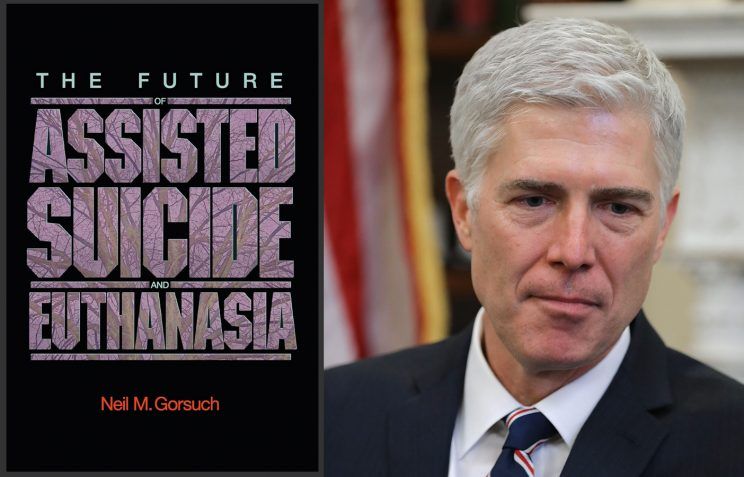This essay is part of a series of advice for Judge Gorsuch. See related articles here.
On February 18, Washington, DC, became the sixth jurisdiction in the United States to permit physician-assisted suicide. Congress failed to intervene in time to prevent the DC Council’s bill from taking effect. DC joins California, Colorado, Oregon, Vermont, and Washington State in allowing the practice.
The fact that only six jurisdictions have legalized assisted suicide so far is not for lack of trying on the part of assisted suicide and euthanasia advocates. In his 2006 book The Future of Assisted Suicide and Euthanasia, Supreme Court nominee Neil Gorsuch notes that between 1994, when Oregon’s voter referendum legalizing the practice passed, and the time of his writing, “over fifty bills have been introduced to legalize assisted suicide or euthanasia in at least nineteen state legislatures, and two voter referenda modeled on Oregon have been attempted. All have failed so far.” Those efforts have only intensified in the last decade. Twenty-four states are reportedly considering or will consider legalizing assisted suicide this year.
Given assisted suicide proponents’ relative lack of success in the legislative arena, it was only a matter of time before they moved on to the judicial branch. Gorsuch’s book offers a thorough and incisive analysis of the legal and moral arguments surrounding assisted suicide and euthanasia. His examination of the judiciary’s engagement with this issue in the past and the prospect of its involvement with it in the future is particularly timely and worth revisiting.
Start your day with Public Discourse
Sign up and get our daily essays sent straight to your inbox.Supreme Court Engagement with Assisted Suicide
While legislative and voter referendum efforts outside of Oregon were being stymied, assisted suicide proponents filed federal lawsuits in New York and Washington State seeking to have those states’ statutory prohibitions on assisted suicide declared unconstitutional. In the wake of clashing rulings (one trial court declared a constitutional right to assisted suicide, while the other did not; both appellate courts found a right to assisted suicide, but they employed different rationales in doing so), the Supreme Court heard arguments in 1997 in both Washington v. Glucksberg and Vacco v. Quill. The Court upheld both states’ statutes prohibiting assisted suicide in 9-0 decisions.
While these decisions were widely hailed as major victories for opponents of assisted suicide and euthanasia, Gorsuch notes that many overlooked the fact that the decisions “addressed only the question whether laws banning assisted suicide are . . . unconstitutional in all applications,” but pointedly did not address “whether those laws are unconstitutional as applied to terminally ill adults seeking death.” The Court has so far not ruled on that particular question.
The Court’s deference to the states on the issue of assisted suicide may not hold if it is squarely confronted with the question of the as-applied constitutionality of state laws prohibiting assisted suicide even to terminally ill patients, or to patients enduring “unbearable suffering” of one sort or another. If the Court’s actions in the last fifty years have established anything, it is that its justices are not afraid to unilaterally quash state-level debate on controversial social issues by judicial fiat.
Weighing Legal Arguments Supporting Legalization
Gorsuch devotes several chapters to evaluating the strength of different arguments in favor of legalizing assisted suicide and euthanasia.
After examining the historical record and noting the difficulties inherent in employing the “history test” as a guide to resolving substantive due process disputes, Gorsuch eventually concludes that legal history does not support recognition of a right to assisted suicide or euthanasia. He then explores the question of procedural fairness. The law has long recognized a patient’s right to refuse medical treatment even when doing so hastens death, but it has not recognized a right to assistance in suicide or to euthanasia. Is this an unfair treatment of actions that are essentially the same? Gorsuch argues that
a morally significant distinction does exist, insofar as one practice (the right to refuse) need not involve an intent to kill on the part of the patient or the patient’s assistant, while the other (assisted suicide) always involves an intent to kill on the part of the principal, and an intent to help kill on the part of the assistant.
This distinction, Gorsuch notes, “has long been embedded in” the common law and in medical ethics, and “the fact that the right to refuse can be used by individuals to effectuate acts of intentional self-destruction” does not mean that the distinction between the two practices is not “rational” for purposes of equal protection review.
Gorsuch next turns to an examination of moral and legal autonomy. Judge Barbara Rothstein, the district court judge who held that Washington’s assisted suicide prohibition was unconstitutional, argued that the Fourteenth Amendment’s “due process” clause guarantees citizens a sweeping right to control their own destiny. Judge Stephen Reinhardt, who wrote the Ninth Circuit’s decision upholding Rothstein’s ruling, found this argument persuasive; likewise, “Justices Stevens and Souter appeared sympathetic to this line of argument, and Justice O’Connor seemed to decline to voice any views with respect at least to terminally ill patients.” It seems likely that the autonomy argument will feature prominently in a future Supreme Court case reviewing an as-applied challenge to a state law prohibiting assisted suicide.
With this in mind, Gorsuch turns to an examination of the Court’s 1992 ruling in Planned Parenthood v. Casey, an abortion case in which the Court upheld several informed consent measures while also striking down a requirement that spouses be notified prior to an abortion. Specifically, Gorsuch wonders whether Casey, and substantive due process reasoning broadly, “are hardy enough to sustain a constitutionally protected autonomy interest that could, in turn, sustain a right to assistance in suicide and euthanasia.”
In Casey, the Court envisioned its role as enforcer of the Constitution’s promise “that there is a realm of personal liberty which the government may not enter.” That realm of personal liberty pertains not just to those rights protected by the Constitution, but includes “all fundamental rights comprised within the term liberty.” Casey’s noteworthy stab at defining and demarcating the limits of liberty is the famous sweet-mystery-of-life passage: “At the heart of liberty is the right to define one’s own concept of existence, of meaning, of the universe, and of the mystery of human life.”
Legal Limits of Autonomy
One might reasonably expect that such a broad reading of the liberty guaranteed to individuals by the Fourteenth Amendment would apply seamlessly to the cause of assisted suicide and euthanasia. Surely the decision to end one’s life with the assistance of a willing party is part of one’s liberty to define one’s own concept of existence and the mystery of human life (and death).
Gorsuch observes, however, that it remains “unclear whether Casey’s ‘mystery of life’ passage is properly understood as a persuasive but nonbinding dictum or an exceptionless holding.” In addition to the mystery-of-life autonomy-based arguments for reaffirming Roe, the Court in Casey also argued that stare decisis—respect for precedent—required a reaffirmation of Roe’s central holding, perhaps even if Roe’s central holding was incorrect (as some of the concurring justices in Casey seemingly thought).
Because “Casey’s reliance on stare decisis was the narrower of the two grounds for decision offered by the plurality,” and given that usually “only the narrowest rationale is said to control future courts,” Gorsuch notes that a good argument can be made that the autonomy rationale favored by the Ninth Circuit and Justice Stevens in the assisted suicide cases is inessential to the plurality holding in Casey. Thus, such a broad reading of Casey may not be extended to future cases on the constitutional status of laws prohibiting assisted suicide.
Complicating any extension of the broad reading of Casey to the issue of assisted suicide is the fact that multiple autonomy interests are at stake—the autonomy interests of those seeking assistance in committing suicide, and the autonomy interests of those who fear that liberal assisted suicide laws will be abused to permit the killing of vulnerable patients against their will—whereas the Court has incorrectly held that the only autonomy interest at stake in the case of abortion is that of the pregnant woman. Even if the broad reading of Casey were extended in an assisted suicide case, evidence presented by Richard Doerflinger in a recent paper for the Charlotte Lozier Institute indicates that the balancing of competing autonomy interests would probably weigh against legalization.
In any event, Gorsuch argues that the broad reading of Casey and its principle that matters “involving the most intimate and personal choices a person may make in a lifetime . . . are central to the liberty protected by the Fourteenth Amendment” proves far too much. Adherence to such a principle would invalidate any prohibition on private consensual acts. Gorsuch echoes Judge Diarmuid O’Scannlain’s piercing question in dissent in the Ninth Circuit proceedings in the Glucksberg case: “If physician-assisted suicide is a protected ‘intimate and personal choice,’ why aren’t polygamy, consensual duels, prostitution, and, indeed, the use of illicit drugs?” This is the very same principle that gave us the Court’s 2015 decision in Obergefell v. Hodges striking down state laws defining marriage as the union of a man and a woman.
Gorsuch helpfully highlights the flawed reasoning that may be employed by the judiciary in the future to strike down state laws banning assisted suicide on the grounds that they are unconstitutional as applied to a discrete group such as the terminally ill. Such a result, which would open up a right to assisted suicide only for a select group, would thereby be reached using an argument that, if applied logically, demands that the same right be extended to all consenting adults (at least).
This result would therefore be temporary: opening up assisted suicide to the terminally ill or unbearably suffering is only the first step for advocates of these practices. The march would go on toward a general right to assisted suicide and euthanasia that our courts would be helpless, on autonomy grounds, to resist. The experience of those European nations experimenting with these practices the longest bears witness to this trajectory and should serve as a stark warning to the United States, especially as a right to die quickly becomes a duty to die. After all, operating in the background of the autonomy claim is the ancillary principle of beneficence: an autonomous request for assisted suicide is necessary, but not sufficient, to secure the desired assistance; also necessary is the judgment of the relevant authorities that one’s life is no longer worth living.
Gorsuch points to the arguments of scholars like Ronald Dworkin, who, in advocating for voluntary euthanasia with arguments from autonomy, seem to transform the “right to die” into “a duty to do so.” Take Dworkin’s example of a woman suffering from Alzheimer’s who previously had expressed a desire to be killed if she ever suffered from dementia but now expresses that she enjoys life and wishes to continue living. Dworkin argues that treating this hypothetical woman as she now wishes and allowing her to live, rather than as she once asked and killing her, “violates rather than respects her autonomy.” The autonomy argument, Gorsuch writes, seems “to go so far as to require society to ignore the plea for life of the demented aged person in favor of some previously signed document or comment that he or she would rather die than become demented.”
Gorsuch’s analysis of the (lack of) limits of the broad definition of protected liberty advanced in Casey points to a lesson to be learned repeatedly: the autonomy-based “reasoned judgment” method of deciding constitutional issues involving “substantive due process” is deeply flawed, and it undermines the structure of our government by making the justices of the Supreme Court into legislators-in-chief.
The opinions expressed here are the author’s own and do not necessarily reflect those of the Institute.














